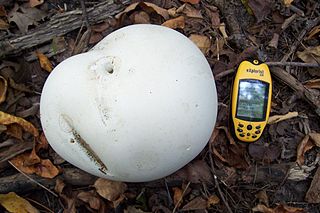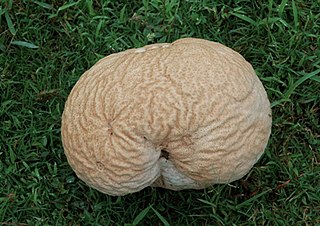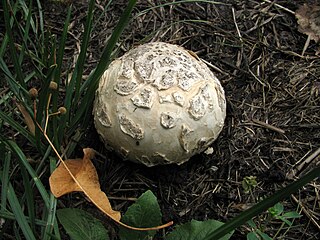
Puffballs are a type of fungus featuring a ball-shaped fruit body that bursts on contact or impact, releasing a cloud of dust-like spores into the surrounding area. Puffballs belong to the division Basidiomycota and encompass several genera, including Calvatia, Calbovista and Lycoperdon. The puffballs were previously treated as a taxonomic group called the Gasteromycetes or Gasteromycetidae, but they are now known to be a polyphyletic assemblage.

Calvatia gigantea, commonly known in English as the giant puffball, is a puffball mushroom commonly found in meadows, fields, and deciduous forests in late summer and autumn. It is found in temperate areas throughout the world.

Calvatia is a genus of puffball mushrooms that includes the giant puffball C. gigantea. It was formerly classified within the now-obsolete order Lycoperdales, which, following a restructuring of fungal taxonomy brought about by molecular phylogeny, has been split; the puffballs, Calvatia spp. are now placed in the family Agaricaceae of the order Agaricales.

Calvatia craniiformis, commonly known as the brain puffball or the skull-shaped puffball, is a species of puffball fungus in the family Agaricaceae. It is found in Asia, Australia, and North America, where it grows on the ground in open woods. Its name, derived from the same Latin root as cranium, alludes to its resemblance to an animal's brain. The skull-shaped fruit body is 8–20 cm (3–8 in) broad by 6–20 cm (2–8 in) tall and white to tan. Initially smooth, the skin (peridium) develops wrinkles and folds as it matures, cracking and flaking with age. The peridium eventually sloughs away, exposing a powdery yellow-brown to greenish-yellow spore mass. The puffball is edible when the gleba is still white and firm, before it matures to become yellow-brown and powdery. Mature specimens have been used in the traditional or folk medicines of China, Japan, and the Ojibwe as a hemostatic or wound dressing agent. Several bioactive compounds have been isolated and identified from the brain puffball.

Gymnopus dryophilus is a mushroom commonly found in temperate woodlands of Europe and North America. It is generally saprophytic, but occasionally also attacks living wood. It belongs to section Levipedes of the genus, being characterized by a smooth stem having no hairs at the base. Until recently it was most frequently known as Collybia dryophila.

Bovista is a genus of fungi commonly known as the true puffballs. It was formerly classified within the now-obsolete order Lycoperdales, which, following a restructuring of fungal taxonomy brought about by molecular phylogeny, has been split; the species of Bovista are now placed in the family Agaricaceae of the order Agaricales. Bovista species have a collectively widespread distribution, and are found largely in temperate regions of the world. Various species have historically been used in homeopathic preparations.

Handkea is a genus of puffball mushrooms in the family Agaricaceae. In 1989, German mycologist Hanns Kreisel described the genus Handkea to include species of Calvatia with distinct microscopic features, including a unique type of capillitium, with curvy slits instead of the usual pores. Although accepted by some authors, the genus concept has been rejected by others.

Geastrum saccatum, commonly known as the sessile earthstar or rounded earthstar, or star of the land, is a species of mushroom belonging to the genus Geastrum. The opening of the outer layer of the fruiting body in the characteristic star shape is thought to be due to a buildup of calcium oxalate crystals immediately prior to dehiscence. G. saccatum is distinguished from other earthstars by the distinct circular ridge or depression surrounding the central pore.

Dissingia leucomelaena, commonly known as the white-footed elf cup, is a species of fungus in the family Helvellaceae of the order Pezizales. As its common name implies, it is characterized by the white coloring of its stem.

Calvatia sculpta, commonly known as the sculpted puffball, the sculptured puffball, the pyramid puffball, or Sierran puffball, is a species of puffball fungus in the family Agaricaceae. Attaining dimensions of up to 8 to 15 cm tall by 8 to 10 cm wide, the pear- or egg-shaped puffball is readily recognizable because of the large pyramidal or polygonal warts covering its surface. It is edible when young, before the spores inside the fruit body disintegrate into a brownish powder. The spores are roughly spherical, and have wart-like projections on their surfaces.

Calbovista is a fungal genus containing the single species Calbovista subsculpta, commonly known as the sculptured puffball, sculptured giant puffball, and warted giant puffball. It is a common puffball of the Rocky Mountains and Pacific Coast ranges of western North America. The puffball is more or less round with a diameter of up to 15 cm (6 in), white becoming brownish in age, and covered with shallow pyramid-shaped plates or scales. It fruits singly or in groups along roads and in open woods at high elevations, from summer to autumn.

Mycenastrum is a fungal genus in the family Agaricaceae. The genus is monotypic, containing one widely distributed species, Mycenastrum corium, known by various common names: the giant pasture puffball, leathery puffball, or tough puffball. The roughly spherical to turnip-shaped puffball-like fruit bodies grow to a diameter of 6–24 cm (2–9 in). Initially covered by a thick, felted, whitish layer, the puffballs develop a characteristic checkered skin (peridium) in age. When the internal spore mass, the gleba, is firm and white, the puffball is edible, although some individuals may suffer mild gastrointestinal symptoms after eating it. As the spores mature, the gleba turns first yellowish then purplish brown. Spores are released when the peridium eventually splits open into irregularly shaped sections. Microscopically, the gleba consists of spherical, dark brown spores with rounded bumps on their surfaces, and a capillitium—intricately branched fibers that form long thorn-like spines. The puffball grows on or in the ground in prairie or desert habitats. Although widely distributed, it is not commonly encountered. Mycenastrum corium is a threatened species in Europe.

Hygrophorus subalpinus, commonly known as the subalpine waxycap, is a species of white snowbank fungus in the family Hygrophoraceae. Found in the mountains of western North America, it is found growing on the ground under conifers, usually near snowbanks.

Mycena overholtsii, commonly known as the snowbank fairy helmet or fuzzy foot, is a species of fungus in the family Mycenaceae. The mushrooms produced by the fungus are relatively large for the genus Mycena, with convex grayish caps up to 5 cm (2 in) in diameter and stems up to 15 cm (6 in) long. The gills on the underside of the cap are whitish to pale gray, and initially closely spaced before becoming well-spaced at maturity after the cap enlarges. The mushrooms are characterized by the dense covering of white "hairs" on the base of the stem. M. overholtsii is an example of a snowbank fungus, growing on well-decayed conifer logs near snowbanks, during or just after snowmelt. Formerly known only from high-elevation areas of western North America, particularly the Rocky Mountain and Cascade regions, it was reported for the first time in Japan in 2010. The edibility of the mushroom is unknown. M. overholtsii can be distinguished from other comparable species by differences in location, or spore size.

Plectania nannfeldtii, commonly known as Nannfeldt's Plectania, the black felt cup, or the black snowbank cup fungus, is a species of fungus in the family Sarcosomataceae. The fruit bodies of this species resemble small, black, goblet-shaped shallow cups up to 3 cm wide, with stems up to 4 cm long attached to black mycelia. Fruit bodies, which may appear alone or in groups on the ground in conifer duff, are usually attached to buried woody debris, and are commonly associated with melting snow. Plectania nannfeldtii is found in western North America and in Asia, often at higher elevations. Similar black cup fungi with which P. nannfeldtii may be confused include Pseudoplectania vogesiaca, P. nigrella, and Helvella corium.
Patricio Ponce de León was a Cuban mycologist. He was a professor at Belen School in Havana and at the University of Havana, and later a curator at the Field Museum of Natural History in Chicago, Illinois. He wrote a monograph on the worldwide species of the family Geastraceae, the earthstar fungi. Ponce de León died in Miami, Florida.

Hygrophorus erubescens, commonly known as the blotched woodwax or pink waxcap, is an agaric fungus native to Scandinavia, Japan, Central Europe, Great Britain and North America.

Bovista pila, commonly known as the tumbling puffball, is a species of puffball fungus in the family Agaricaceae. A temperate species, it is widely distributed in North America, where it grows on the ground on road sides, in pastures, grassy areas, and open woods. There are few well-documented occurrences of B. pila outside North America. B. pila closely resembles the European B. nigrescens, from which it can be reliably distinguished only by microscopic characteristics.

Bondarzewia mesenterica is a species of polypore fungus in the family Bondarzewiaceae. It was first described as Boletus mesentericus by Jacob Christian Schäffer in 1774. Hanns Kreisel transferred it to the genus Bondarzewia in 1984. The species is edible.

Calvatia pachyderma, also known as the elephant-skin puffball or thick-skinned puffball, is a species of edible fungus. This mid-sized, spring-fruiting puffball is known from relatively dry, open places near human settlements. The appropriate binomial name, taxonomic placement, and geographic distribution "have been much debated and are the subject of controversy".


















